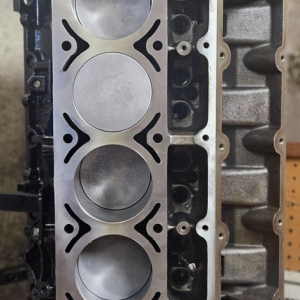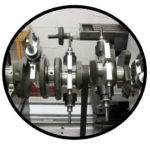Engine Balancing For Small Blocks. Chevy-Chrysler-Ford
$325.00
Description
Here at Benning Auto Parts we use a precision balancing process on our computerized CWT balancing program. With this process our target is +/- 1 gram. All performance engines should be balanced because of the much lighter pistons the industry is using today.
Simply put, the main reason is to eliminate damaging and parasitic forces that causes unwelcome mechanical activity and robs the engine of its ability to freely transmit all of its power directly to the wheels.
Most people overlook the fact that all engines from the first stage of manufacturing go through some process of balancing. When the crankshaft and all related components are manufactured they have to be shaped and weighed to meet a target weight specification.
The crankshaft is then designed with counter weights that offset the thrusting and rotating forces generated via the combustion activity that causes the engine to rotate. OK, this is generally known and understood.
But what we need to understand is that the engines that were used just a few decades ago were running at a relatively low RPM band as compared to the engines that we are currently receiving from the OEM’s. Notice that I am talking about the “Grocery Getter” not Hi-Performance. Let me give you some information that hopefully will get your attention.
When the OEM’s such as GM, Ford and Chrysler produced a typical vehicle they would generally accept a balancing specification of 2.0 Ounce-Inch tolerance, so what does that mean. The 2.0 ounce-inch tolerance means that on a typical crankshaft that has a total diameter of 6.0 inches it will have 18.95 grams of unbalance weight residually embedded in the outside edge of the counter weights.
When the engine is running @ 1000 RPM (just above Idle), the embedded weight will cause the rotating crank assembly to generate a centrifugal unbalance force of 3.56 pounds. As we increase the RPM to 2000 the unbalance force increases to 14.25 pounds and at 4000 RPM it is now 56.5 pounds and 8000 RPM will generate 228 pounds of force.
Now you must understand even though the unbalance force has increased from 3.56 pounds to 228, the physical embedded weight of 18.95 is still exactly the same. Only by increasing the RPM can we increase the generated unbalanced force.
So you say we rarely operate the engine at 4000 RPM thus the 56+ pounds of force is not a big deal.
Well let me explain that if you had a 56 pound hammer and you dropped it on say the hood of your car you would notice an unwelcome dent. So lets imagine that hood of you car is an engine bearing. This bearing is receiving a pounding of this 56 pound hammer at a rate of 66+ times per second (4000 RPM).
Even though the bearing can probably handle the pounding force, the energy from this is transferred into the main bearing housing and it will cause distortion causing a host of new problems, especially with the newer light weight blocks. So if the bearing in your engine could talk then, …..well I think you are getting the picture. To balance your engine we will need the following items: Crankshaft, 8 rods, 8 pistons, 1 set piston rings. 1 set of rod bearings, harmonic balancer, flexplate or flywheel & bolts. If manual shift we will need clutch pressure plate and bolts. Clutch disc NOT required. The final “Balance Sheet” is provided with each job showing the before and after balance numbers. “Unleash Your Engines Horsepower” and save your investment.
Related products
-


Engine Crankshaft Machining
$275.00 Add to cart -

GM 5.7L 1986-1989 CAST IRON BLOCK HO PISTONS SB CRATE ENGINE STAGE 1 PERFORMANCE CAMSHAFT
$2,785.00 Add to cart -

GM LS 4.8/5.3L Upgrade Your Ride – 312CI SHORT BLOCK FLAT TOP HO PISTONS COMPUTER BALANCED SB CRATE ENGINE
$3,395.00 Add to cart -

GM LS 5.3L SHORT BLOCK FLAT TOP HO PISTONS COMPUTER BALANCED SB CRATE ENGINE
$3,385.00 Add to cart


